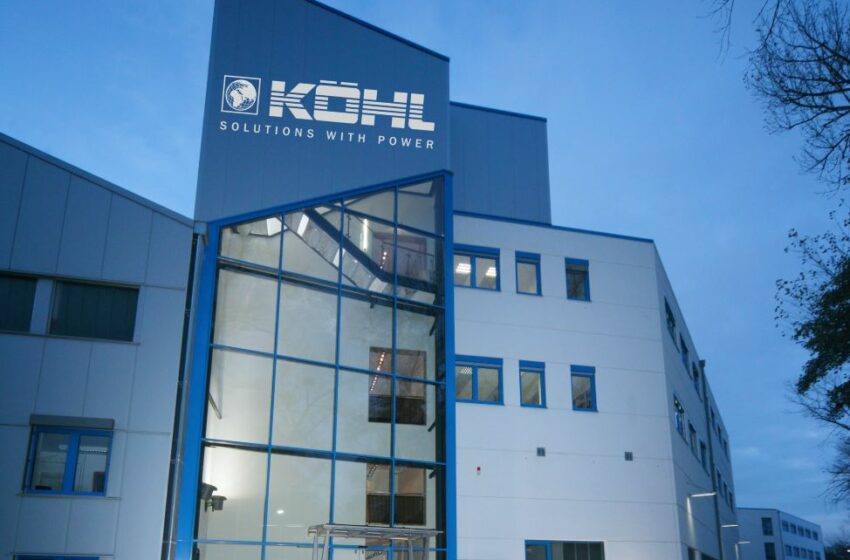Smart and Smooth
- Also in TR Print Edition
- May 1, 2024
- 0
- 9 minutes read

Koehl operates out of Wecker, town in Luxembourg near the German border | Photos: Koehl Machinenbau

Stefan Hahn, managing director of Koehl, discusses the latest trends in cigarette manufacturing.
By Stefanie Rossel

Production efficiency continues to be a priority for tobacco companies. On the road to “Industry 4.0,” the world’s four leading cigarette manufacturers are focusing heavily on automation, ranging from information technology to operation technology, according to Stefan Hahn, managing director of Koehl Maschinenbau, a Luxembourg-based supplier of primary processing and logistics solutions.
Intralogistics, which involve all flows of goods and materials on a company’s site, are increasingly important. Optimizing the coordination of processes is a key challenge in today’s intralogistics system implementation.
Greenfield factories exemplify the seamless integration of internal logistics: Their highly automated shop floors consist, for instance, of a series of halls that are arranged on both sides of a long corridor aptly called “the spine.” Here, mobile robots that transport materials from the pallet to the machine have the right of way on dedicated lanes much wider than the footpaths. The spacious halls, which among others accommodate the Primary department, the filter-making division and the secondary, feature wide spaces between production lines, allowing the robots to maneuver. Below the ceiling, a filter segment supply buffer system completes the flow of materials.
“When planning a factory from scratch, it’s easy to accommodate comprehensive intralogistics solutions,” says Hahn. “Tobacco manufacturers, however, currently seek to automate their existing plants, and this often proves to be a challenge. Today, several meters between production lines is standard, but when some of the older plants were built, machinery was placed much closer to each other. Or take the factory of one of our customers: Here, production is spread over three floors, which means that AGVs [automated guided vehicles] have to take the elevator to reach all production lines.”
Koehl is well positioned for such challenges. While tobacco solutions still account for 50 percent to 60 percent of the company’s turnover, the company has two additional, fast-growing business units that specialize in intralogistics and robotics, respectively, and a department that focuses on automation and IT, where programmers enable production lines to communicate with the customer’s enterprise resource planning and business intelligence systems. “Automation is our daily business,” Hahn says. The company currently has more programmers than design engineers. This reflects a strategic focus on software development within the organization, highlighting the critical role of programming in its operations and product offerings. The balance between technical disciplines is essential to drive innovation and maintain competitive advantage in the market.
The company currently has more programmers than design engineers.

Wanted: Flexible and Robust Machinery
Koehl is also active in enabling the implementation of the Open Platform Communications Unified Architecture Tobacco Machinery Communication (TMC) standard, which Philip Morris International, BAT, Japan Tobacco International and Imperial Brands jointly developed to describe general requirements for manufacturers of primary and secondary machinery that apply to both machine-to-machine and machine-to-business communication (see “Smart Connection,” Tobacco Reporter, September 2022). Koehl has already realized the first projects to integrate the standard.
The company’s machinery complies with the TMC standard. In addition, Koehl has developed a solution for shop floors with equipment from different suppliers that was developed before the standard was introduced. Koehl also provides an interface service that facilitates integration for suppliers aiming to enter or expand within the tobacco industry. Its machine-to-cloud solution, the IIoT Server, enables vertical data transmission to a business intelligence system without, in the best case, changing the components’ programming. This way, all data accumulated on the shop floor can be semantically processed in the same way to collect and analyze it centrally.
In the future, Hahn expects the number of employees in a cigarette factory to remain the same but that their tasks will change. “The transportation of physical items like paper, cigarettes and shrink film may become obsolete through the automation possibilities,” he says. “The focus will shift toward enhancing the efficiency of production processes. This evolution will prioritize innovation and optimization over traditional logistics.”
Regarding tobacco machinery in general, Hahn sees two main trends, one being maximum flexibility.
“In the future, the trend will shift away from highly specialized machinery capable of producing massive quantities of a single product,” he says. “The focus will instead be on versatile equipment that can swiftly adapt to various formats, catering to a market that values diversity over volume. This approach aims to minimize the setup time and enhance efficiency in manufacturing processes. For this reason, we have revised, for example, our track-and-trace portfolio to quickly adapt to changes in packaging formats and cover a wide range of product variations.”
The other important theme is “robustification,” which means minimizing the risk of errors and protecting against hacking.

Solution for Complex Tasks
Koehl operates out of Wecker, near the German border, where it has 120 employees, including engineers, programmers and visualizers. The company develops it innovations in close cooperation with its customers. Its location in Trier, Germany, is a manufacturing facility, where 60 people build all tobacco machinery, intralogistics and robotics solutions and clients can carry out preliminary acceptance tests.
The medium-sized company manages multiple projects simultaneously, each with significant financial stakes, which requires a high level of coordination and expertise. Koehl aims to expand its annual turnover of €40 million ($42.63 million). The plan depends in part on the company’s ability to fill 25 to 30 additional positions, as Germany presently experiences a shortage of specialists.
In the tobacco industry, Koehl occupies a lucrative niche with its specialized machinery in the primary and secondary areas, such as its patented Flavour Application System (FAS 4 Evolution), an enhanced flavor application system offering numerous benefits to customers. The latest version optimizes the flavor application process in tobacco, filter and next-generation product manufacturing and features state-of-the-art software. An optimized feedforward controller effectively eliminates startup waste while an integrated radio frequency identification system ensures complete traceability from filling to application. An additional benefit of the FAS 4 Evolution is its compatibility with all current makers. Its design allows quick flavor changes, enhancing efficiency and flexibility in production processes.
The company also caters to track-and-trace requirements for other tobacco products (OTP), which will take effect in the EU on May 20, 2024. Koehl adapted its track-and-trace system for cigarettes, which can apply an individual code into a black field on the pack without damaging the foil, for OTP applications. “OTP machinery runs at a much slower speed than cigarette packaging equipment, but there is vast product and format variety, including pouches, cans, outers, tins, wooden boxes or buckets,” says Hahn. “It’s a challenge to handle all these different sorts of bundles, so we had to develop new machinery for OTP tracking and tracing.”
While tobacco manufacturers in recent years focused their investments primarily on the secondary department—a development that was among other things driven by track-and-trace requirements—Hahn is convinced that companies will soon look more closely at their primaries again. “The primary sector’s machinery, some of which dates back 30 [years] to 40 years, incurs significant maintenance and energy expenses and poses potential safety hazards to workers,” he says. “It is anticipated that by 2030, there will be a substantial rise in investment to modernize this equipment.”

